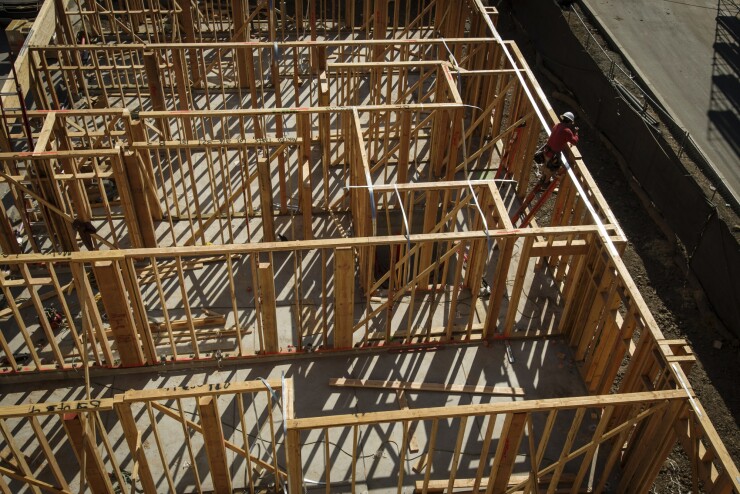County supervisors approve a disputed project. Gov. Gavin Newsom agrees to a statewide housing policy. President Trump moves to ease home-construction regulations across the nation.
Last week was a busy one on the housing front — and those are just the highlights.
All of this activity comes amid the ongoing debate about what government should do to bring down the cost of housing. There is sharp disagreement over this fundamental question: Would simply building more homes lower prices?
The need for housing was the rallying cry of supporters for the 1,119-home project east of Chula Vista called Adara at Otay Ranch, which was approved by the county Board of Supervisors on a 3-2 vote Wednesday. Hours of debate preceded the vote, much of it over whether it was safe to build a suburban development in a high-risk fire zone. Critics further contend this market-rate housing project would do little to provide affordable homes.
The proposal is among several that would place about 10,000 homes in outlying areas prone to wildfire, though developers say they have adequate evacuation plans and will adhere to building standards that require the use of fire-resistant materials and other defenses.

Environmentalists say such projects run counter to state and local goals to limit greenhouse gases that contribute to climate change. Nicole Capretz, executive director of the Climate Action Campaign, took to Twitter to say the approval of Adara blew up efforts to resolve pending litigation.
"Due to County vote approving sprawl & runaway increases in GHg, our attempt to settle our lawsuit w County over their Climate Action Plan is over," she said in a post. "We already won in (superior) court, now sadly we have to waste more time litigating. It's Groundhog Day. Imagine what kids will say."
As with most everything about building housing, development in high fire-prone areas is not just a San Diego concern. Several days ago, Gov. Newsom's task force on wildfire safety released a progress report that said the panel was looking at several areas. Among them were suggestions to "prioritize building in less fire-prone areas" and require local planners to "incorporate fire-risk projections into planning for housing developments."
The day after the supervisors' vote, the governor announced an agreement with state Senate Pro Tempore Toni Atkins, D-San Diego, and Assembly Speaker Anthony Rendon, D-Lakewood, that would take a carrot-and-stick approach to encourage local governments to allow more housing to be built. Under the agreement as part of the new budget, cities and counties that adopt programs making it easier to build will move to the head of the line for certain grants.
Those that fail to follow the state's housing-element law may be taken to court and face a judge's order to comply. There would be no penalties in the first year, but thereafter, jurisdictions could be fined $100,000 to $600,000 per month if they don't adhere to the court order. The state could withhold certain funding if the fines aren't paid. A key point here is the housing law requires local governments to plan for how much housing they need to meet growth, but not necessarily approve it.
The budget, which takes effect Monday, will provide $650 million for homeless services, including emergency shelters. That comes on top of $500 million in the current-year budget signed by then-Gov. Jerry Brown.
On Tuesday, Trump signed an executive order creating a panel to look at getting rid of housing regulations that the administration says add more than 25% to the cost of new homes.
That move came a week after Sen. Todd Young, R-Ind., introduced the YIMBY Act, which would require governments that apply for HUD grants to show how they are making zoning less "discriminatory" or explain why they are keeping existing housing policies in place.
The legislation, named after the "Yes In My Backyard" housing movement, suggests several policies state and local governments could adopt. Many of them can be found in recent California legislation: Allow higher densities, including in single-family home neighborhoods; reduce parking requirements; approve projects "by right," which avoids discretionary government action if the development adheres to existing community plans; and streamline the permitting process.
The measure also seeks to eliminate local restrictions on short-term vacation rentals, such as those advertised by Airbnb.
The politics here don't fall along typical partisan lines. While Republicans in Washington are pushing the issue, in Sacramento it's largely Democrats. YIMBY groups in California, which have grassroots appeal but are also backed by tech companies such as Microsoft and Pantheon, have mostly young Democratic members. They contend local opposition to new development has exacerbated the high cost of housing, pricing potential first-time homebuyers out of the market.
Critics contend density increases and reduced regulations will only benefit developers, may even make housing more expensive and gentrify older neighborhoods, forcing existing residents who can't afford the new homes to move. They also say it will destroy the character of single-family home areas. San Diego City Councilwoman Barbara Bry made some of those arguments last week in criticizing her main opponent for mayor of San Diego, Assemblyman Todd Gloria, who supports moves to increase density.
He and other housing advocates dispute such claims, pointing out that the key state housing legislation — the unsuccessful Senate Bill 50 — required projects to include lower-cost units and had protections for existing tenants. Opponents said that wasn't enough.
The main components of SB 50 called for higher density along transit corridors and multi-family units in single-family neighborhoods. A similar bill had previously failed.
Whether or not the third time is the charm, a new version of that legislation seems certain to come around again.





